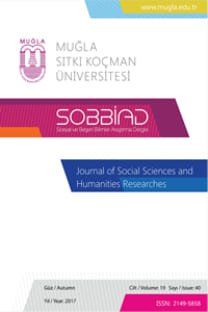KÂBUSTAN UYANIŞ: SEAMUS HEANEY’NİN ŞİİRİNDE İRLANDA SORUNU ve ÇÖZÜM ÖNERİLERİ
Seamus Heaney, ‘İrlanda Sorunu’ olarak bilinen Protestan-birlik yanlısı ve Katolik-milliyetçi topluluklar arasındaki yetke kavgasının temelinde, Keltlerdeki Nerthus inancının yattığına inanır. Ozan şiirlerinde, bataklıklara atılarak Tanrıça Nerthus’a kurban sunulan insanlarla, cumhuriyetçi şehitlik anlayışının özgür bir İrlanda için yaşamlarını feda etmeye çağırdığı yurttaşları benzeştirir. Böylece yaşanan karmaşanın gerçekte, ekonomik, politik, tarihsel ve sınıfsal nedenlerden değil, yüzyıllardır süregelen şiddet geleneğinden kaynaklandığına vurgu yapar. Ona göre, İrlanda, sözü edilen sorundan ancak hoşgörü, sağduyu, özveri ve duygudaşlık gibi değerleri yücelterek kurtulabilir. Heaney’nin düşünü kurduğu, İrlandalılık bilinci ile dolu herkesi kucaklayan bir İrlandadır.
Anahtar Kelimeler:
Seamus Heaney, İrlanda Sorunu, Nerthus, şiir, şiddet
Awakening from Nightmare: Irish Troubles and Solution Suggestions in the Poetry of Seamus Heaney
Seamus Heaney believes that Nerthus cult in ancient Celts underlies the power struggle, which is known as ‘Irish Troubles’, between Protestant-Unionist and Catholic-Nationalist communities. The poet, in his poems, likens the bog people sacrificed for Goddess Nerthus to the citizens the republican sense of martyrdom calls to lay down their lives for the sake of a free Ireland. Thus, he underlines that the current chaos, in fact, has not stemmed from economic, political, historical and denominational reasons, but from the tradition of violence which has been going on for centuries. To him, Ireland can get rid of the said troubles only by crediting the merits such as tolerance, common sense, altruism and empathy. What Heaney dreams about is an Ireland embarrassing everybody flushed with Irish consciousness.
Keywords:
Seamus Heaney, Irish Troubles, Nerthus, poetry, violence,
___
- Corcoran, Neil. (1998). The Poetry of Seamus Heaney. London-Boston: Faber and Faber
- Haffenden, John. (1981). Viewpoints: Poets in Conversation with John Haffenden. London: Faber and Faber
- Heaney, Seamus. (1972a). Wintering Out. London: Faber and Faber
- ________(1972b). “Mother Ireland”. The Listener, 7 December, s. 790
- ________(1975). North. London: Faber and Faber
- ________ (1979). Field Work. London-Boston: Faber and Faber
- ________ (1987). The Haw Lantern. London: Faber and Faber
- ________(1995). Crediting Poetry. Loughcrew-Oldcastle-County MeathIreland: Gallery Press
- ________(1996a). Preoccupations: Selected Prose 1968–1978. 8 th Printing, New York: Farrar, Straus and Giroux
- ________ (1996b). The Spirit Level. London-Boston: Faber and Faber
- ________ (2003). Finders Keepers: Selected Prose 1971–2001. London: Faber and Faber
- Joyce, James. (1997). Ulysses. (Çev. Nevzat Erkmen), 3. Baskı, İstanbul: Yapı Kredi Yayınları
- _______ (1996). A Portrait of an Artist as Young Man. England-Berkshire: Penguin Books , Kittay, Eva Fedder. (2005). “Equality, Dignity and Disability”. M. A. Lyons & F. Waldron (Eds.), Perspectives on Equality: The Second Seamus Heaney Lectures, Dublin: The Liffey Press, s. 93-119
- Lloyd, David. (1996). “Fusions in Heaney’s North”. C. Malloy & P. Carey (Eds.), Seamus Heaney: The Shaping Spirit, Newark & London: University of Delaware Press & Associated University Presses, s. 82- 90
- O’Neill, Charles L. (1996). “Violence and the Sacred in Seamus Heaney’s North”. C. Malloy & P. Carey (Eds.) Seamus Heaney: The Shaping Spirit, Newark & London: University of Delaware Press & Associated University Presses, s. 91-105
- Randall, James. (1979). “An Interview with Seamus Heaney”. Ploughshares, 5:3, s. 7-22 The European Union Constitution. (16 December 2004). Part I, Title I, Article 8, Official Journal of the European Union, C 310, Volume 47, http://eurlex.europa.eu/LexUriServ/LexUriServ.do?uri=OJ:C:2004:31 0:0011:0040:EN:PDF [06.07.2010]
- Vendler, Helen. (1998). Seamus Heaney. Cambridge/Massachusetts: Harvard University Press Verdonk, Peter. (1993). “Poetry and Public Life: A Contextualized Reading of Seamus Heaney’s ‘Punishment’”. P. Verdonk (Ed.), Stylistic Criticism of Twentieth-Century Poetry: From Text to Context, Florence-USA: Routledge, s. 112-133
- ISSN: 2149-5858
- Yayın Aralığı: Yılda 2 Sayı
- Başlangıç: 2000
- Yayıncı: Mugla Sitki Kocman University
Sayıdaki Diğer Makaleler
KÂBUSTAN UYANIŞ: SEAMUS HEANEY’NİN ŞİİRİNDE İRLANDA SORUNU ve ÇÖZÜM ÖNERİLERİ
Ayşen Temel EGİNLİ, Selin BİTİRİM
ATATÜRK DÖNEMİ HAYVANCILIK POLİTİKASI
II. DÜNYA SAVAŞI YILLARINDA EGE ADALARI’NDAN BATI ANADOLU SAHİLLERİNE SIĞINAN MÜLTECİLER MESELESİ
KARİYER DEĞERLERİ VE KARİYER YOLU TERCİHLERİ İLİŞKİSİ: TÜRK TURİZM SEKTÖRÜNDEN ÖRNEKLER
Türkiye’de Dil Öğretiminde Motivasyon ve Verimliliği Arttırmaya Yönelik İlgi Tabanlı Dil Öğretimi
KÜRESELLEŞME VE DEMOKRASİ KRİZİ
Seyahat ve Cinsiyet: Bir Kadının Portresi
